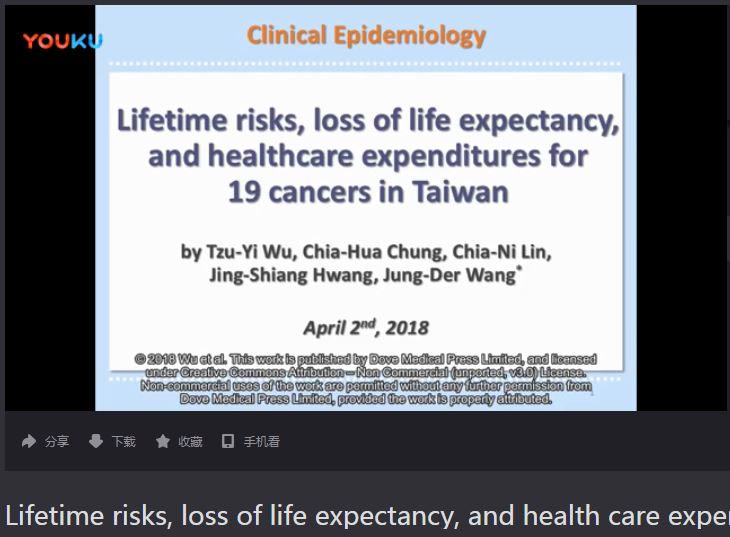9 0 5 7 8
论文已发表
注册即可获取德孚的最新动态
IF 收录期刊
- 2.6 Breast Cancer (Dove Med Press)
- 3.9 Clin Epidemiol
- 3.3 Cancer Manag Res
- 3.9 Infect Drug Resist
- 3.6 Clin Interv Aging
- 4.8 Drug Des Dev Ther
- 2.8 Int J Chronic Obstr
- 8.0 Int J Nanomed
- 2.3 Int J Women's Health
- 3.2 Neuropsych Dis Treat
- 4.0 OncoTargets Ther
- 2.2 Patient Prefer Adher
- 2.8 Ther Clin Risk Manag
- 2.7 J Pain Res
- 3.3 Diabet Metab Synd Ob
- 4.3 Psychol Res Behav Ma
- 3.4 Nat Sci Sleep
- 1.9 Pharmgenomics Pers Med
- 3.5 Risk Manag Healthc Policy
- 4.5 J Inflamm Res
- 2.3 Int J Gen Med
- 4.1 J Hepatocell Carcinoma
- 3.2 J Asthma Allergy
- 2.3 Clin Cosmet Investig Dermatol
- 3.3 J Multidiscip Healthc

Lifetime risks, loss of life expectancy, and health care expenditures for 19 types of cancer in Taiwan
Authors Wu TY, Chung CH, Lin CN, Hwang JS, Wang JD
Received 1 November 2017
Accepted for publication 8 March 2018
Published 25 May 2018 Volume 2018:10 Pages 581—591
DOI https://doi.org/10.2147/CLEP.S155601
Checked for plagiarism Yes
Review by Single-blind
Peer reviewers approved by Dr Justinn Cochran
Peer reviewer comments 4
Editor who approved publication: Professor Irene Petersen
Background: The mortality rates for different cancers are no longer an
efficient tool for making national policy. The purpose of this study were to
quantify the lifetime risks, life expectancies (LEs) after diagnosis, expected
years of life lost (EYLL), and lifetime health care expenditures for 19 major
cancers in Taiwan.
Methods: A total of 831,314 patients with 19
pathologically proven cancers were abstracted from the Taiwan Cancer Registry
from 1998 to 2012. They were linked to the National Mortality Registry
(1998–2014) and National Health Insurance reimbursement database (1998–2013) for
survival and health care costs. We estimated the cumulative incidence rate for
ages 0–79 years and the lifetime survival function for patients with different
cancer sites. The EYLL was calculated by subtracting the LE of each cancer
cohort from that of the age- and sex-matched referents simulated from national
life tables. The estimated lifetime cost was calculated by adding up the
product of survival probability and mean cost at the corresponding
duration-to-date after adjustment for the inflation to the year of 2013.
Results: There were 5 cancers with a lifetime risk
exceeding 4%: colorectal, liver, lung, and prostate in males, and breast and
colorectal in females. Cancers with EYLL of >10 years were: esophageal,
intrahepatic bile ducts, liver, pancreas, oral, nasopharyngeal, leukemia, lung,
and gallbladder, extrahepatic bile ducts and biliary tract in males, and
intrahepatic bile ducts, pancreas, nasopharyngeal, lung, esophageal, leukemia,
liver, gallbladder, extrahepatic bile ducts and biliary tract, ovary, and
stomach in females. Cancers with lifetime health care expenditures exceeding
US$50,000 to the National Health Insurance were as follows: leukemia, kidney,
testis, renal pelvis and ureter in males, and renal pelvis and ureter,
leukemia, breast, urinary bladder, kidney, ovary, and nasopharyngeal in
females. All these impacts should be considered in health policy decisions.
Conclusion: The impacts of cancer in Taiwan are very large.
Future studies must consider both quality of life and the entire impact from
societal perspectives.
Keywords: health impacts,
incidence rate, expected years of life lost, cancer prevention
摘要视频链接:Lifetime risks, loss of life
expectancy, and health care expenditures
